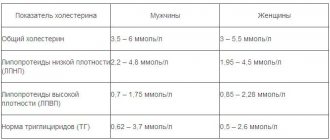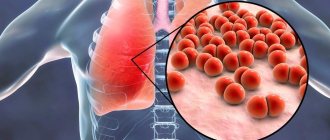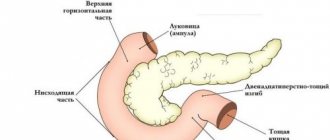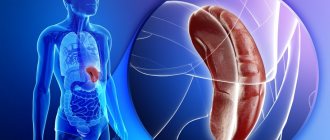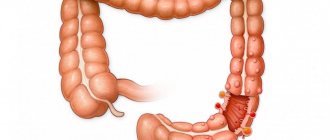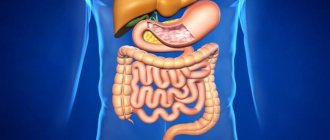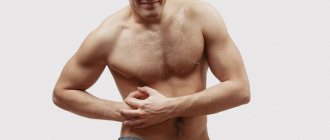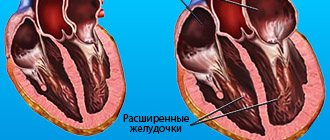There are situations when delay in providing medical care can cost a person’s life. These conditions are associated with pain, manifested in acute or chronic form. As you know, a painful attack is the body’s cry for help, so pain cannot be ignored.
Let's consider a situation where the right side hurts under the ribs, on the side of the lower edge of the right rib. What it could be, what pathologies are behind the pain syndrome in this area - the answers to these questions will help you assess the seriousness of the situation and make the right decision when the symptom in question is detected.
What is on the right side of a person?
Pain in the right side under the ribs can be either reflected from organs located in the immediate vicinity or radiating (radiating) from other parts of the abdominal cavity or chest. On the right under the ribs and on the side of a person there are:
- liver;
- gallbladder;
- the lower edge of the pulmonary pleura (lining of the lung);
- colon;
- right adrenal gland.
Pain on the right under the ribs can be provoked by damage or inflammation in these organs, as well as in organs located below - the appendix, prostate, bladder or above and to the left - the heart sac (pericardium), the pleura of the right lung or the diaphragm.
Abdominal wall
These are soft tissues that prevent damage to the internal organs that are located on the left side of a person’s lower abdomen. When complaining of acute or nagging pain, patients most often point to the anterior left part of the abdominal wall. It consists of several layers:
- skin and subcutaneous fat - this layer is characterized by inflammation of the hair follicles, which in some cases can cause painful rashes;
- the internal organs that are located on the left side of the abdomen are protected from damage by a layer of muscles attached to the inner wall of the abdominal cavity (these are the rectus abdominis and oblique abdominal muscles);
- fascia - dense sheets of connective tissue that separate muscles.
The back and side walls of the abdominal cavity are much thicker, since powerful back muscles are located there.
Pain in the peritoneum can occur due to peritonitis, pelvioperitonitis, acute or chronic mesadenitis.
Why the pain?
If there are no questions about the location of the organs, it’s time to turn to an explanation of the reasons that make these organs hurt. You can identify the provocateur of pain under the right rib on the side using special distinctive features.
Why does it hurt when moving?
It is worth paying attention to what circumstances (fatty foods, dynamic loads, etc.) lead to pain on the right side. For example, pain in the right side when moving may indicate the presence of several pathologies:
The characteristic features of pain associated with cholelithiasis are difficult to confuse with other pain sensations; it is not for nothing that they are called hepatic or biliary colic. Usually they have a paroxysmal and pronounced character, which is explained by the movement of stones along the biliary tract.
Steatohepatosis, or “fatty liver” is accompanied by the introduction of fatty patches into hepatocytes (liver cells), the liver parenchyma grows and becomes unable to perform its functions. The overgrown gland irritates nearby nerve endings, especially when moving, and causes pain.
If it hurts under the ribs when jogging, it means that the liver, not accustomed to physical activity, filled with blood too quickly, which is why its capsule stretched and began to put pressure on the surrounding nerve endings. The reason in this case is lack of training.
If the pain is acute
Acute pain on the right, in front or on the side under the ribs should be treated with special attention, because it signals that very urgent (urgent) situation that requires an immediate call for an ambulance.
- If the pain feels like it is “creeping” down, this may be a sign of acute inflammation of the appendix (appendicitis), which requires urgent surgical intervention.
- In case of urolithiasis, sharp pain radiating to the iliac region indicates that a kidney stone has entered the orifice of the ureter.
- In women, acute pain in the right side can be symptoms of urgent conditions such as ectopic pregnancy, torsion of the pedicle of an ovarian cyst, or apoplexy (rupture) of this organ. The latter is confirmed by heavy bleeding.
- Pain in the right side in men is most often associated with acute liver failure caused by alcohol intoxication or injury.
- Sharp pain that intensifies when changing body position can be caused by pinching of the intercostal nerve. Such pain can subside when moving the body into a comfortable position.
- If the pain is on the right under the ribs, the pain is “pecking” and appears suddenly, this is almost 100% “hepatic colic” caused by spasm of the bile duct or blockage of its mouth by a calculus or tumor.
In medical practice, sudden hepatic colic is considered very rare, since they are usually preceded by recurrent nagging pain on the side under the ribs.
The Deepest Essence of Digestion
Every high school student knows that digestion occurs in the stomach. Aggressive hydrochloric acid attacks the food entering the stomach, and it begins to break down into easily digestible components.
| Not often, but it happens | |
| Epigastric pain may be a signal of myocardial infarction. After all, in the area of the solar plexus there are not only the digestive organs - the lungs and heart are nearby. So you should not tolerate acute abdominal pain. If it doesn’t work, call an ambulance. | |
In addition, epigastric pain may be of neurological origin. That is, in the thoracic spine, one or another nerve is sandwiched between the vertebrae - and the signal is transmitted along the nerve to the stomach. A neurologist will be able to “decipher” such pain after an X-ray or CT scan of the spine.
But not every school graduate knows that a person without a stomach can live relatively normally. Because only the first stage of digestion takes place here. Much more important processes occur in the next “compartment” - the duodenum. The pancreatic ducts and the common bile duct exit here.
The gall bladder accumulates bile produced by the liver, and as soon as food enters the duodenum, the bile is sent there to help with digestion. An equally important role in digestion is played by the so-called “pancreatic juice” - the secretion of the pancreas, which also enters the duodenum through the ducts.
Other localization of pain symptom
Having figured out what hurts to the right of the costal arch, let’s remember about pain that has a different localization. These are pains that arise in the abdominal cavity or radiate to the back.
Front
If it hurts under the ribs in the front, you should look for the causes of the symptom in diseases of the organs located in the abdominal cavity:
- pancreas;
- duodenum and colon (large) intestine;
- diaphragm.
Sometimes the pinched intercostal nerve “hurts” in the front of the ribs; in this case, the patient can find a position in which the pain symptom is almost not bothersome.
Epigastric (in the triangle under the ribs) pain is often observed during an attack of ischemic heart disease. Only a thorough diagnosis will help clarify the true cause of the pain syndrome.
From the back
Pain that shoots through the right side and the area under the ribs from the back can be associated with pathologies of the adrenal glands, osteochondrosis, diseases of the female reproductive system - adnexitis and others. Taking tests, ultrasound or x-ray examinations will allow you to differentiate pain symptoms and establish the cause of their occurrence.
A sign of the development of pathological processes in the spleen
The spleen is a small but extremely important organ of the human body. It is located on the left side, at the very top of the abdominal cavity. The close location of the spleen to the surface of the body makes it an organ very vulnerable to external injury. In addition, organ enlargement is caused by internal pathological processes.
When the spleen begins to increase in size - in the area under the heart, a dull pain impulse will appear on the left. Pathologies in the spleen need to be identified as soon as possible, because a strong increase in the size of the organ causes rupture of the spleen, which can be fatal.
Causes of pain under the ribs on both sides
The occurrence of unpleasant sensations under the ribs causes a lot of anxiety. Most often, the pain is aching and tends to radiate to the shoulder, back and other parts of the body. The clinic corresponds to various diseases of the gastrointestinal tract, spleen, liver, pancreas, gallbladder and its ducts.
If it hurts on the left side and radiates slightly to the right, then the cause is an enlarged spleen. And changes in size can be caused by diseases such as hemolytic anemia, acute infectious pathologies, autoimmune disorders, and septic conditions.
Discomfort or a burning sensation in the hypochondrium on both sides are signs that appear against the background of acute and chronic pathologies. The only difference is the severity, since in the acute course of the pathological process the pain syndrome is stronger.
Unpleasant sensations under the ribs have causes:
- Injury to the spleen, liver or other organs of the hepatobiliary tract.
- Formation of retroperitoneal hematoma.
- Gastrological type of myocardial infarction - there is pain on both sides of the ribs, and it hurts to breathe.
- Pathologies of the respiratory and urinary system.
- Osteochondrosis.
- Neurological disorders, etc.
The symptoms that accompany the pain syndrome will be of great help in the diagnostic process - cough, tightness in the chest, fever, increased body temperature, nausea, digestive dysfunction, etc.
Why else can the solar plexus hurt?
Let's look at less common causes of pain under the solar plexus:
- Intestines. When the duodenum or small intestine is inflamed, pain appears just below the solar plexus. If the pain is low, then perhaps the pathological process affects part of the large intestine.
- Wearing tight things. More often than not, women suffer from this when they choose narrow clothes. In this case, pain below the solar plexus will be associated with wearing certain clothes.
- Irritation of the nerve plexuses. Nerve plexuses are localized in the celiac region, irritation of which can be accompanied by pain. The provoking factor will be hard work or injury.
Pain in the solar plexus can occur for various reasons. But if pain occurs frequently or painful discomfort does not go away for a long time, you should visit a doctor.
Dangerous liver diseases
In acute conditions, pain appears unexpectedly, the symptom tends to increase, so in most cases, emergency medical assistance is required to prevent complications and save the patient’s life.
Acute viral hepatitis in humans
Acute hepatitis of viral origin is an inflammatory lesion of the liver tissue, which is manifested by a number of signs of hepatic cellular failure and intoxication, which leads to a severe deterioration in well-being.
During the incubation period - from the moment the viral agent enters the body until the appearance of the first clinic, different times pass, since everything is determined by the number of pathogens that have entered the body.
In the acute form of the disease, a dull/sharp pain is observed on the right in the area of the liver projection, which can radiate to the back. The pain syndrome is based on hepatomegaly - an increase in the size of the internal gland. The liver itself cannot hurt, but when the membrane grows strongly, the pain manifests itself.
- Before the icteric period, there was only discomfort and heaviness in the right side. Signs most often occur after drinking alcohol, food, or physical activity. In some cases, body temperature rises and a runny nose appears. Characteristic signs are changes in the color of urine and feces.
- During the icteric stage, the skin and mucous membranes become yellowish. The liver and spleen increase in size, there is a clinic of intoxication. At this stage, the pain syndrome is more pronounced.
- At the end of the icteric period, the skin gradually returns to normal, but enzymatic activity is still elevated.
Against the background of clinical manifestations, it is necessary to undergo examination, since the disease tends to transform into a chronic course, fraught with the development of cirrhosis, hepatocellular carcinoma.
Leptospirosis
This is an acute zoonotic infectious disease caused by the penetration into the body of a bacterium that belongs to the Leptospira family.
- Fever, chills - symptoms occur suddenly. Body temperature rises to 39-40 degrees.
- Pain in the right and/or left side, since leptospira affects not only the liver, but other organs, spreading through the circulatory system.
- Hyperemia, swelling of the face, increased vascular pattern of the eyes.
- Other manifestations of the infectious process cannot be excluded. In a child, leptospirosis is similar to the clinical picture of herpes - rashes appear on the lips and mucous membranes.
- Polymorphic swelling - occurs several days after an increase in temperature and pain.
Leptospirosis can affect both the liver and lungs, resulting in the formation of bronchitis, which is accompanied by coughing and sputum streaked with blood.
Legionellosis
A severe infectious disease manifested by general intoxication, damage to the central nervous system and urinary system.
The cause is the pathological activity of gram-negative anaerobes of the Legionella family.
Most often, the disease occurs as pneumonia.
- Pain in the right side due to an enlarged liver and discomfort under the ribs on the left, as the size of the spleen changes upward.
- Dyspeptic disorders - nausea, sometimes vomiting, loss of appetite.
- Chills, increased sweating, headache.
- When intoxication affects the central nervous system, patients experience hallucinations and impaired consciousness.
After 3-4 days from the onset of the disease, a cough appears - at first it is non-productive, then sputum mixed with purulent masses (sometimes with blood) is released. The disease is dangerous, since the lack of qualified assistance leads to the development of infectious-toxic shock, and the mortality rate in this case is up to 20%.
Acute cholecystitis
An inflammatory process in the gallbladder caused by a violation of the discharge of bile due to a blockage of the waste pathways.
The main symptom is acute pain in the area of the liver and upper abdomen. In some cases, the pain radiates under the right shoulder blade, the left half of the body. Additional signs include nausea, vomiting with bile, and an increase in temperature to the level of low-grade fever.
How to determine what hurts under the heart?
Step 1: It is important to listen to the symptoms the person is experiencing. It is advisable to thoroughly determine exactly where the pain is felt.
Listen to the symptoms
Step 2. You should describe the nature of the pain and understand what it is - acute, dull, girdling, etc.
Determine the nature of the pain
Step 3. It is necessary to assess your condition and determine what other accompanying symptoms are present - for example, nausea or vomiting, dizziness, darkening of the eyes.
Identify associated symptoms
Step 4. If the pain is severe, you should not self-medicate - it is important to call an ambulance as quickly as possible.
Don't self-medicate
Step 5. If you have persistent pain, you should visit a doctor.
Step 6. It is important to undergo all examinations recommended by a specialist and pass all tests.
Complete all examinations
Video – Human Anatomy
Knowing what is under the heart and determining which organ is causing concern, you can significantly narrow the range of possible problems and even try to eliminate the pain yourself. But only a specialist can make an accurate diagnosis.
Did you like the article? Save so you don't lose!
| It is directly involved in the production of a number of hormones and T-lymphocytes, launches regenerative processes, and activates the immune system. |
| A wall of muscle tissue that serves as a separator between the abdominal and thoracic regions. Takes part in respiratory processes. |
| The organ responsible for digesting food. Products entering the body are broken down here under the action of gastric juice. |
| It is directly involved in metabolic processes, helps the body maintain the required level of immunity, and cleanses the blood of toxins. |
| The organ produces enzymes that help food digest. The gland is also responsible for producing hormones necessary to regulate glucose levels. |
Chronic liver diseases in humans
Chronic liver pathologies under the influence of factors - poor nutrition, violation of doctor's recommendations, pregnancy, etc. tend to worsen, which leads to the appearance of a characteristic clinic.
Chronic hepatitis
This is inflammation in the liver, which leads to fibrotic transformations and necrotic changes in cells and tissues, while there is no disruption of the structure of the lobules. Signs of the disease are determined by the degree of damage to the gland and the type of hepatitis.
As the disease progresses, symptoms appear:
- Increased gas formation.
- Decreased appetite.
- Sleep disturbance.
- Headache.
- Loss of body weight.
- Jaundice.
- Periodic pain in the right side.
- Pain on the left side due to the enlargement of the spleen.
- Skin itching.
Based on palpation, the doctor diagnoses diffuse hepatomegaly or an increase in only one lobe, increased liver density.
Fatty degeneration
Fatty liver is an independent syndrome or a secondary one, as a result of which lipid compounds accumulate in the liver tissues.
According to statistics, the disease is most often diagnosed in obese women. In 60-70% of pictures there are no symptoms.
Obvious symptoms of disease progression:
- Abdominal discomfort.
- Aching pain in the right side (mild).
- Hepatomegaly, when touching the right side it hurts.
In some cases, fatty liver is accompanied by dyspeptic disorders and jaundice.
Cirrhotic lesion
Cirrhosis is a disease in which full-fledged liver tissue degenerates into fibrous connective structures. The severity of the clinic is based on the degree of damage to the gland and the activity of cirrhotic processes. At the initial stage, manifestations are minimal, there is no pain.
Over time, discomfort appears under the ribs, digestion is disrupted, and the temperature increases to the level of low-grade fever. As the pain progresses, it intensifies and radiates to different parts of the abdomen and back; jaundice is observed, characteristic signs are redness of the palms, transformation of the nail plates, spider veins on the body.
Tumor neoplasms
Neoplasms of benign (cysts, hemangiomas) and malignant nature (primary, secondary cancer) in the liver do not show symptoms in the initial stages. As the tumor grows, the capsule stretches, which leads to pain.
It can be different - the pain is dull, aching, bursting, sharp. Localization is the right side, irradiation is to the stomach, to the right side under the ribs, to the back, shoulder blade and shoulder. Painful sensations initially appear periodically, but over time they become constant.
Dyskinesia of the bile ducts
This is a functional disorder of the motility of the gallbladder and its channels, the processes of bile discharge. In the hypertensive-hyperkinetic course, acute pain syndrome is observed on the right side, which radiates to the back and right shoulder blade.
Against the background of hypokinetic-hypotonic dyskinesia, patients complain of constant, low-intensity, dull and aching pain in the area of the liver projection, a feeling of fullness and stretching in this area.
Pain, heaviness, discomfort in the right side under the ribs when moving, after a heavy meal - all these are signals that the body sends us that not everything is fine. And it is better to pay attention to these initial warning signs while the disease has just begun to develop, rather than face further aggravation and exacerbation. To recognize the disease on time, it is important to know which organs are located in the right hypochondrium.
Diagnosis and treatment
Having found out what is under the heart and a sign of what diseases pain in this area may be, you still won’t be able to diagnose yourself. One can only guess what caused the discomfort. And only a medical professional can determine the true cause and prescribe appropriate treatment.
At the doctor
The doctor will refer the patient for a number of examinations, including blood, urine, stool, ultrasound, etc. tests. Only after receiving the test results, as well as collecting an anamnesis, will the specialist be able to establish a diagnosis.
What organs are on the right side of a person?
It’s not uncommon to hear someone say, holding their right side, “Oh, it’s probably a bad liver.” Such a statement rarely turns out to be true, since it is the liver that cannot hurt: there are no nerve endings in this organ. However, it is surrounded by Glisson's capsule. When the liver enlarges as a result of painful processes occurring in it, it puts pressure on the capsule, which causes pain. There are also many other organs on the side to the right, and each of them can produce painful symptoms.
Let's look at the right hypochondrium - what is in this place:
- Right section of the diaphragm
- Upper intestines
All these organs are located on the side in front. Each of them can give off discomfort, dull and sharp, stabbing and encircling pain in the right hypochondrium in front. But even this is not an exhaustive list.
Pain may radiate to the right with:
- Rib fractures
- Gastritis and stomach ulcers
- Inflammatory processes occurring in the intestines
- Osteochondrosis
- Intercostal neuralgia
- Appendicitis
- Right-sided pneumonia or pleurisy
- Various types of oncological processes
Let's talk about the liver
It is important to know where a person’s liver is located, although it cannot become a source of pain. By enlarging due to the pathological processes occurring in it, the liver can put pressure on neighboring organs, causing a noticeable feeling of discomfort. If in your youth you can be forgiven for wondering whether the liver is on the left or the right, then at an older age it will make itself felt with a feeling of heaviness after a heavy or fatty meal.
A few more signs that the liver is the culprit of the problem:
- Dry and itchy skin, especially the palms
- Yellowing of the skin, cornea of the eyes, mucous membranes in the mouth
If such symptoms appear, you don’t have to think about where the liver is, but feel free to take a ticket to a hepatologist or, in extreme cases, a gastroenterologist.
Liver disease usually extends directly under the ribs. However, on the lower surface of the organ there are so-called gates. At the porta hepatis there are the hepatic artery, portal vein, common hepatic duct, lymph nodes and lymph vessels. Problems can also arise here - thrombosis, cysts, inflammation of the lymph nodes. All these pathologies are easily detected by ultrasound.
Can the appendix under the ribs hurt?
Everyone knows in which direction a person’s appendicitis is located, and they begin to remember it if the localization of pain is located deep in the lower right abdomen or around the navel. However, not all so simple. As pain develops, it may well radiate to the liver area. In addition, in 17% of people the appendix may be located atypically. If the process of the cecum is turned upward, then the pain will radiate precisely under the right rib in front.
Gallbladder problems
Cholecystitis is the most common pathology of the gallbladder. Inflammation of the gallbladder occurs in both children and adults. It is characterized by: prolonged pain after eating fatty foods, nausea, fever. Cholecystitis is perhaps the most common cause of pain in this area. As the disease progresses, stones may form in the gall bladder, obstructing the release of bile. With further development of gallstone disease, pain in this area will increase, and the pain may begin to radiate to the upper abdomen and sternum.
The root of the problem is in the pancreas
Inflammation of the pancreas is called pancreatitis. The incidence of pancreatitis in children is 9-12 cases per 100,000, and in adults – up to 50 cases per 100,000 people. Pancreatitis is a disease of poor nutrition. Indulgence in fast food, fatty foods, and sweets can cause its development. The disease also develops rapidly in those who abuse alcohol. Pain with pancreatitis can occur in the right hypochondrium or on the right at waist level, spread to the middle of the abdomen, be localized to the left of the navel, and even shoot under the shoulder blade.
Can the diaphragm hurt?
When thinking about what organ is located under the right rib, few people remember the diaphragm. Meanwhile, this is a very important organ that stimulates the breathing process. The diaphragm may hurt due to physiological reasons during pregnancy, a hernia may form in it, and an abscess may begin. Diaphragmatic pain can be similar to gastroenterological pain. Diseases of the diaphragm manifest themselves in severity in the epigastric region, under the ribs. Symptoms may increase after eating and may be aggravated by vomiting. In addition, breathing becomes more difficult, heart rhythm is disturbed, and shortness of breath occurs when lying down.
The right kidney is the source of pain in the right hypochondrium
We looked at which organ is located under the right rib in the front, but we must not forget about the organs located below and behind. Pain in them can also radiate to the right side and right hypochondrium. Kidney diseases are diagnosed after tests for OAM, etc. The most common are pyelonephritis, kidney stones, and renal failure. More often, with kidney disease, the lower back hurts or the pain goes lower.
However, pain in the right hypochondrium may be accompanied by the following symptoms characteristic of kidney disease:
- Swelling in the morning
- Problems with urination
- Low-grade fever
- Weakness and loss of appetite
Evgeniy Stepanishchev
Tyoma recently became indignant about “false facts” - completely ridiculous stereotypes that many adhere to.
It doesn’t matter that as an example he cited two equally ridiculous stereotypes living in his head (by the way, Lenya Kaganov wrote a much more successful article on this subject). One of the false facts that irritates me is “the heart is on the left,” because people quite often, with the words “the heart hurts,” put their hand somewhere in the area of the left armpit.
People take doctors' words too literally: as if the heart is located just behind the left boob. I learned that this was not true in elementary school when I saw my own heart x-ray. I would like to reveal this truth now to those readers who do not know this (and who also skipped that anatomy class or have never wondered why in first aid classes, when doing a heart massage, the hands are placed in the middle of the chest).
The heart is located slightly to the left of the middle of the sternum and slightly lower than the place where the hand is usually placed for pain. I drew two approximate lines in the photo: vertical - the spine, horizontal - the level of the armpits, to make it easier to find the heart on yourself.
Now you know where to put your hand when your heart hurts.
PS What prompted me to write this post was a picture on the Lebedev Studio website in the “Diarrhea” section.
PPS After writing it, I thought that not everyone will be able to find a heart if they have never seen an x-ray of it. The heart is a white bag, starting with a crosshair, and “lying” on the white large one at the bottom of the photo.
It's probably also worth mentioning that in about one in ten thousand, the heart is located closer to the right side (and their liver is on the left). This is called “transposition of internal organs.” I won’t write dextrocardia, but if you’re interested, you can look it up on Wikipedia.
Location of the hypochondrium
The hypochondrium is the part of the epigastrium that extends at the top under the two outermost lower ribs. The right subcostal region is located under the right costal pair, and the left one is located under the left. The upper border of the subcostal zone runs along the line of the diaphragm - a thin elastic plate that separates the peritoneum from the chest. By drawing imaginary lines to the right and left from the iliac bones to the navel, you can determine where the anterior borders of the right and left lower hypochondrium are located. Posteriorly, the lower border of the right hypochondrium runs along the 12th rib and the third lumbar vertebra. If you place the palm of your right hand horizontally on the ribs so that the wrist is in the middle of the side, and the edge of the little finger coincides with the edge of the lower ribs, then turn the hand back so that the position of the wrist does not change, and clasp the back with the palm, this will help visually establish the localization of the posterior lower projection of the right hypochondrium.
Pathologies of the diaphragm
The diaphragm is a broad muscle that separates the thoracic region from the abdominal cavity. There is a small hole in it through which a section of the esophagus is laid, connected to the stomach. If the muscles in this area weaken, which is a fairly common occurrence in older people, the upper gastric section may prolapse through the enlarged lumen. In this case, a diagnosis of “diaphragmatic hernia” is made.
Discomfort from the diaphragm occurs:
- Due to the close proximity of other organs in the lower and upper abdomen, which provokes pain on the left.
- When changing body position and certain movements - turning or bending.
Muscle soreness may not be associated with a hernia; it occurs due to injury or damage that somehow affects the diaphragm.
Also, the area of the left hypochondrium accounts for the location of the diaphragm. Its function is to separate the thoracic area from the abdominal area. And if it weakens, this can lead to disruption of its functions, and, accordingly, to pain, including on the left under the ribs.

